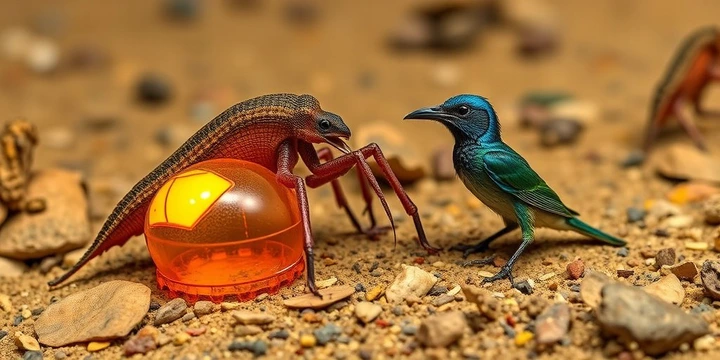
View pictures in App save up to 80% data.
The finding of fossilized chewing lice eggs in mid-Cretaceous Burmese amber has ushered in a new era in our comprehension of ectoparasitism and the evolutionary lineage of parasites. A research team spearheaded by Prof. Diying Huang from the Nanjing Institute of Geology and Palaeontology, part of the Chinese Academy of Sciences, has uncovered conclusive evidence of lice that infested early feathered vertebrates during the Mesozoic period. This discovery not only emphasizes an essential chapter in the story of evolution but also illuminates the intricate dynamics between parasites and their hosts.
Fossil records of parasite-host relationships from the Mesozoic era have been remarkably scarce, especially concerning those parasites that thrived on feathers. The discovery of fossilized louse eggs marks a significant advancement in understanding the history of lice, which are notoriously challenging to analyze because of their fragile structure and specific preservation requirements. The careful research that culminated in this finding included the analysis of amber samples that contained these remarkable specimens, allowing scientists to acquire deep insights into the evolutionary processes occurring during that time.
During their microscopic analysis, the research team found that the amber sample contained numerous fossilized lice eggs affixed to the barbs of feather remnants. Each feather barb exhibited a consistent pattern of elongated eggs that were astonishingly arranged along the shaft, similar to present-day lice yet exhibiting distinct traits. Analyzing the configuration and adhesion of these eggs has been crucial in differentiating them from their modern counterparts, providing new insights into the evolutionary changes of these ectoparasites.
Professor Huang's research team not only discovered these ancient eggs but also conducted a detailed morphological analysis of the preserved feathers, indicating their probable connection to enantiornithines—an ancient lineage of birds that thrived during the Mesozoic era. These results offer concrete evidence of the parasitic interactions that existed between these birds and lice, demonstrating that early feathered vertebrates were susceptible to ectoparasitism far earlier than had been previously recognized.
Lice, which are prevalent ectoparasites in contemporary ecosystems, primarily target birds and mammals. This highlights the importance of examining their evolutionary history to gain insights into host-parasite interactions. Recent research indicates that the lineage of modern lice originated around 99 million years ago, during the Mesozoic era. This era represented a pivotal evolutionary phase when lice evolved from free-living organisms to parasites, developing specialized adaptations for attachment and reproduction on their hosts.
The finding of fossilized eggs is groundbreaking, as previous discoveries of adult lice trapped in amber did not offer the same level of proof regarding the origins of parasitism. The eggs identified in this research reinforce the theory that lichens established parasitic connections with their hosts at various points in evolution, particularly focusing on birds that evolved intricate feather designs for warmth and visual display.
The method by which these lice eggs attach has received considerable interest. Measuring around 512 micrometers in length, the eggs are spaced between 526 and 748 micrometers apart. This particular configuration, combined with a cement-like adhesive that anchors the eggs to the feather shafts, indicates an evolutionary benefit for reproduction and survival. It enhances the chances of successful hatching and the ensuing parasitic activity on the host.
These evolutionary changes encompassed variations in the structure of eggs from ancient lice compared to modern species, highlighting the considerable divergence that has occurred over millions of years. The improvements in microscopy techniques employed to study these fossils enabled scientists to observe fine details essential for comprehending the evolutionary trajectory of these lice as they adapted to their environments and hosts over time.
In addition, the findings of this study reach far beyond simple fossil records. By analyzing the preserved eggs of lice, the research offers a deeper insight into the ways specific ecological niches were utilized throughout the Mesozoic era. These interactions highlight a sophisticated network of life during that period and emphasize the role of parasitism in influencing the evolutionary path of vertebrates.
This pioneering research on fossilized louse eggs highlights the intricate relationships among various life forms, demonstrating that even the tiniest ectoparasites have significantly influenced the evolution of their hosts. It posits that parasitism is a crucial element of ecological interactions, reinforcing the necessity of examining ancient ecological frameworks to gain insights into contemporary relationships.
As scientists delve deeper into various amber specimens, they expect to uncover new discoveries that could shed light on the ancient ecosystems of the Mesozoic era. The likelihood of gaining further understanding about the interactions between insects and vertebrates is significant, making this a promising pathway for continued paleontological exploration.
In conclusion, the progression of ectoparasitism has experienced several independent origins, significantly influencing host adaptation throughout history. The fossilized eggs of chewing lice examined in this research provide essential insights into the evolutionary enigmas surrounding parasitic associations, highlighting the complex ecological relationships that have shaped the diversity of life in our history.
Subject of Research: Fossilized chewing lice eggs and their implications for ectoparasitism in Mesozoic birds.
Article Title: Cretaceous chewing-louse eggs on enantiornithine birds.
News Publication Date: [Date not provided].
Web References: [Web references not provided].
References: [References not provided].
Image Credits: ©Science China Press
Keywords: Fossilized chewing lice, ectoparasitism, Mesozoic era, drinking birds, enantiornithine birds, evolutionary biology, amber fossils, parasitic behavior.
Explore additional insights from the realm of Science.
Sign up to receive the newest posts directly in your inbox.